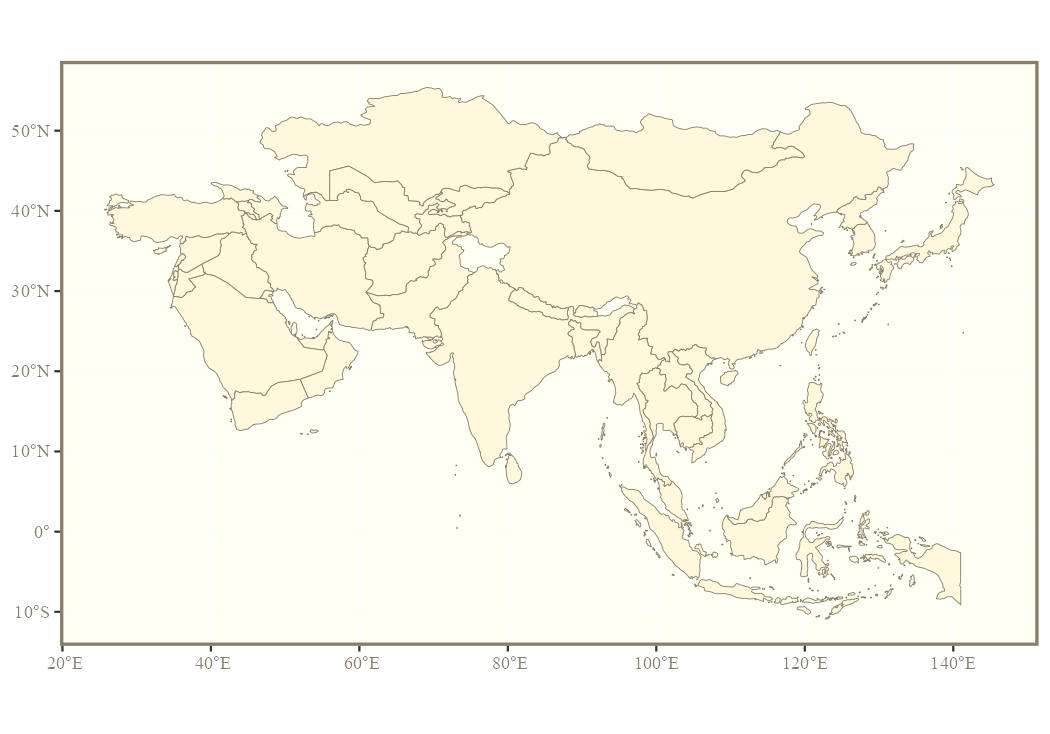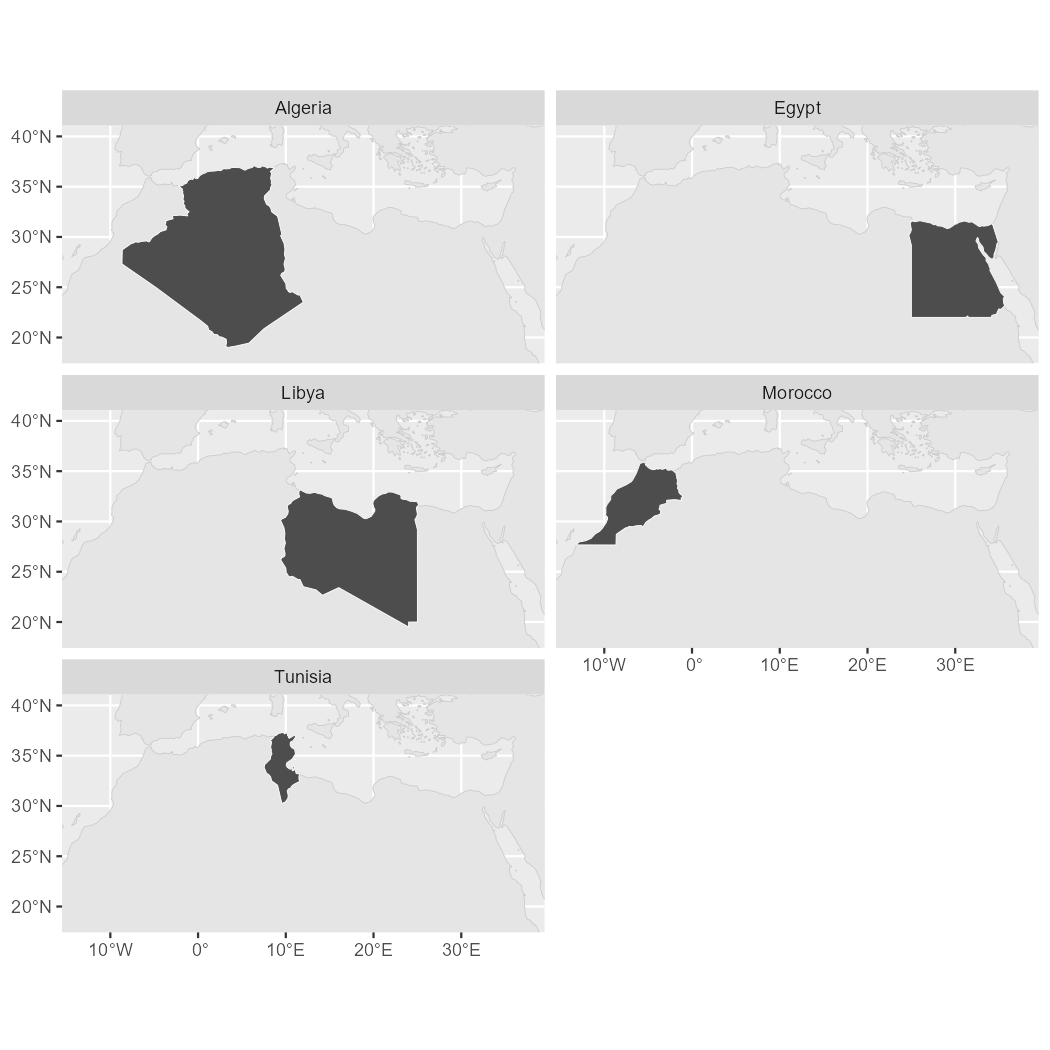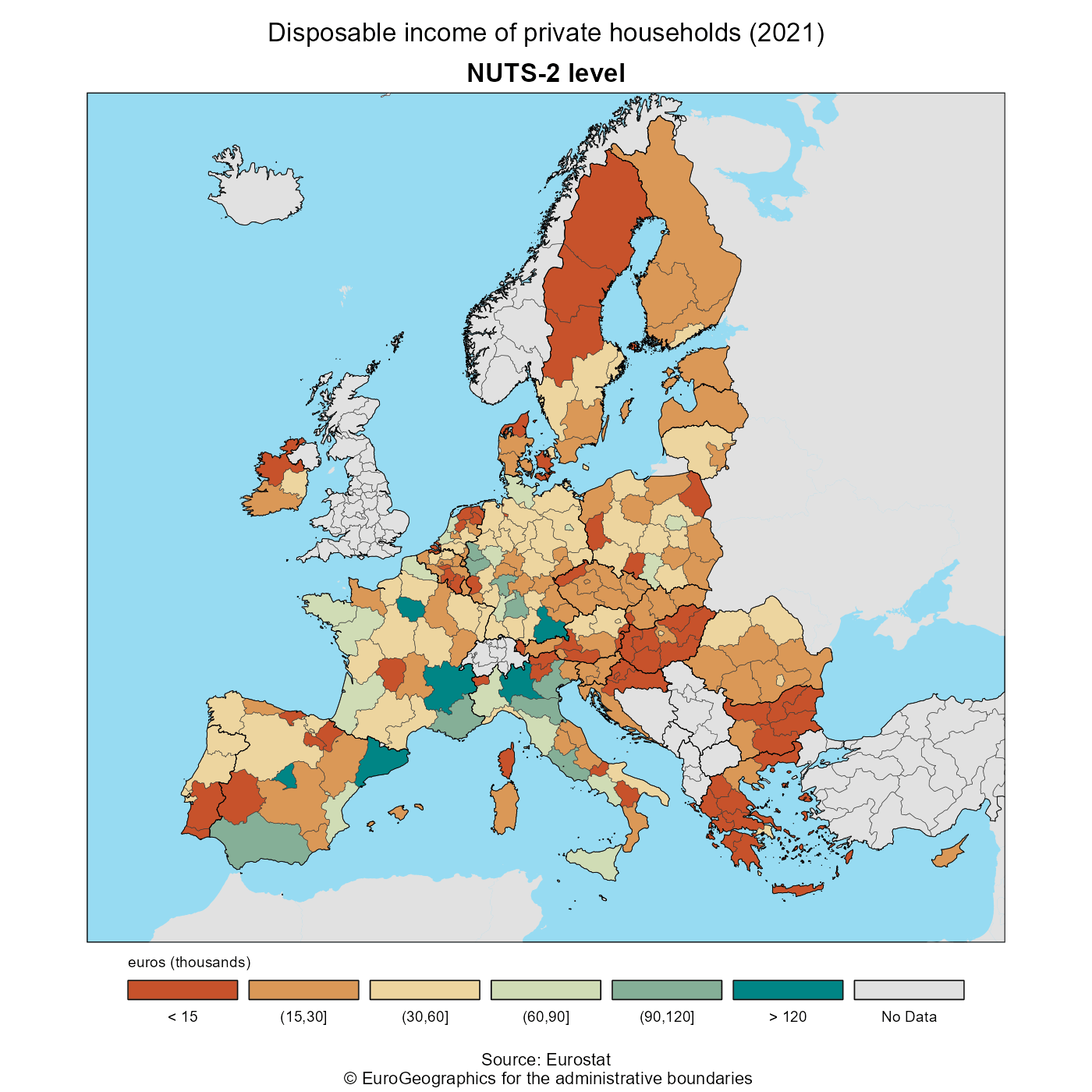Introduction
Full site with more examples and vignettes on https://ropengov.github.io/giscoR/
giscoR is a package designed to provide a clean interaction with the GISCO API.
Within Eurostat, GISCO is responsible for meeting the European Commission’s geographical information needs at 3 levels: the European Union, its member countries, and its regions. GISCO also provides a variety of shapefiles on different formats, focusing specially in the European Union area, but providing also some worldwide shapefiles, as country polygons, labels or borders and coastal lines.
GISCO provides data on different resolutions suitable for representing small areas (01M, 03M) as well as lightweight datasets specially useful for representing wider areas (10M, 20M, 60M). Shapefiles are provided on 3 different projections: EPSG 4326, 3035 or 3857.
giscoR returns sf
class objects, see https://r-spatial.github.io/sf/.
Caching
giscoR provides a dataset caching capability, that could be set as:
gisco_set_cache_dir("./path/to/location")If the file is not available locally, it would be downloaded to that directory so the next time you need the corresponding data it would be loaded from the local directory.
If you experience any problems on downloading, you can also manually download the file from the GISCO API website and store it on your local directory.
Downloading data
Please be aware that downloading provisions apply when using GISCO data:
When data downloaded from this page is used in any printed or electronic publication, in addition to any other provisions applicable to the whole Eurostat website, data source will have to be acknowledged in the legend of the map and in the introductory page of the publication with the following copyright notice:
- EN: © EuroGeographics for the administrative boundaries
- FR: © EuroGeographics pour les limites administratives
- DE: © EuroGeographics bezüglich der Verwaltungsgrenzen
For publications in languages other than English, French or German, the translation of the copyright notice in the language of the publication shall be used.
If you intend to use the data commercially, please contact EuroGeographics for information regarding their licence agreements.
There is a function, gisco_attributions() that would
guide you on this topic. It also provides attributions on several
languages.
library(giscoR)
gisco_attributions(lang = "en")
#> [1] "© EuroGeographics for the administrative boundaries"
gisco_attributions(lang = "fr")
#> [1] "© EuroGeographics pour les limites administratives"
gisco_attributions(lang = "de")
#> [1] "© EuroGeographics bezüglich der Verwaltungsgrenzen"Basic example
Some examples on data downloads
library(sf)
library(ggplot2) # Use ggplot for plotting
asia <- gisco_get_countries(region = "Asia")
ggplot(asia) +
geom_sf(fill = "cornsilk", color = "#887e6a") +
theme(
panel.background = element_rect(fill = "#fffff3"),
panel.border = element_rect(colour = "#887e6a", fill = NA, linewidth = 1.5),
axis.text = element_text(
family = "serif", colour = "#887e6a",
face = "bold"
)
)
Political map of Asia
You can select specific countries by name (in any language), ISO 3 codes or Eurostat codes. The only restriction is that you can’t mix country names, ISO3 and Eurostat codes on one single call.
It is possible also to combine different shapefiles, just set
resolution and epsg (and optionally
year) to the same value:
africa_north <- gisco_get_countries(
country = c(
"Morocco", "Argelia", "Libia",
"Tunisia", "Egypt"
),
resolution = "20", epsg = "4326", year = "2016"
)
# Coastal lines
coast <- gisco_get_coastal_lines(
resolution = "20",
epsg = "4326",
year = "2016"
)
# Plot
ggplot(coast) +
geom_sf(color = "grey80") +
geom_sf(data = africa_north, fill = "grey30", color = "white") +
coord_sf(xlim = c(-13, 37), ylim = c(18.5, 40)) +
facet_wrap(vars(NAME_ENGL), ncol = 2)
Political map of North Africa
Thematic maps with giscoR
This is an example on how giscoR can play nicely
with some Eurostat data. For plotting purposes we would use the ggplot2
package however any package that handles sf objects (e.g.
tmap,
mapsf,
leaflet,
etc. could be used).
Also colorspace and rcartocolor packages are recommended, as they provide great color palettes.
# EU members
library(dplyr)
library(eurostat)
nuts2 <- gisco_get_nuts(
year = "2021", epsg = "3035", resolution = "10",
nuts_level = "2"
)
# Borders from countries
borders <- gisco_get_countries(epsg = "3035", year = "2020", resolution = "3")
eu_bord <- borders %>%
filter(CNTR_ID %in% nuts2$CNTR_CODE)
# Eurostat data - Disposable income
pps <- get_eurostat("tgs00026") %>%
filter(TIME_PERIOD == "2021-01-01")
nuts2_sf <- nuts2 %>%
left_join(pps, by = "geo") %>%
mutate(
values_th = values / 1000,
categ = cut(values_th, c(0, 15, 30, 60, 90, 120, Inf))
)
# Adjust the labels
labs <- levels(nuts2_sf$categ)
labs[1] <- "< 15"
labs[6] <- "> 120"
levels(nuts2_sf$categ) <- labs
# Finally the plot
ggplot(nuts2_sf) +
# Background
geom_sf(data = borders, fill = "#e1e1e1", color = NA) +
geom_sf(aes(fill = categ), color = "grey20", linewidth = .1) +
geom_sf(data = eu_bord, fill = NA, color = "black", linewidth = .15) +
# Center in Europe: EPSG 3035
coord_sf(xlim = c(2377294, 6500000), ylim = c(1413597, 5228510)) +
# Legends and color
scale_fill_manual(
values = hcl.colors(length(labs), "Geyser", rev = TRUE),
# Label NA
labels = function(x) {
ifelse(is.na(x), "No Data", x)
},
na.value = "#e1e1e1"
) +
guides(fill = guide_legend(nrow = 1)) +
theme_void() +
theme(
text = element_text(colour = "grey0"),
panel.background = element_rect(fill = "#97dbf2"),
panel.border = element_rect(fill = NA, color = "grey10"),
plot.title = element_text(hjust = 0.5, vjust = -1, size = 12),
plot.subtitle = element_text(
hjust = 0.5, vjust = -2, face = "bold",
margin = margin(b = 10, t = 5), size = 12
),
plot.caption = element_text(
size = 8, hjust = 0.5, margin =
margin(b = 2, t = 13)
),
legend.text = element_text(size = 7, ),
legend.title = element_text(size = 7),
legend.position = "bottom",
legend.direction = "horizontal",
legend.text.position = "bottom",
legend.title.position = "top",
legend.key.height = rel(0.5),
legend.key.width = unit(.1, "npc")
) +
# Annotate and labels
labs(
title = "Disposable income of private households (2021)",
subtitle = "NUTS-2 level",
fill = "euros (thousands)",
caption = paste0(
"Source: Eurostat\n ", gisco_attributions()
)
)
Disposable income of private households by NUTS 2 regions (2021)
